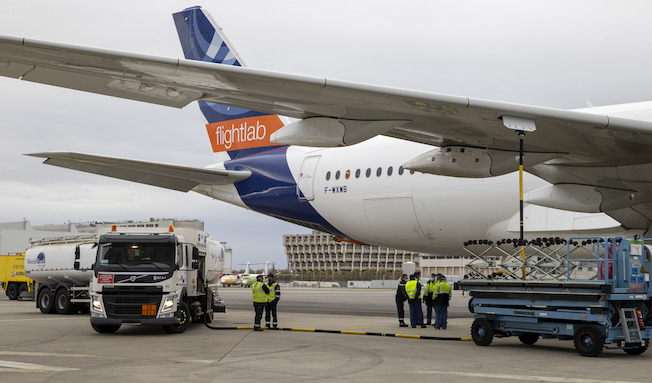The study of sustainable aviation fuel (SAF)’s impact on the full scope of aircraft emissions has been few and far between. An Airbus-led project is looking to change that by conducting a series of flight and ground tests aimed at shedding light on the emissions performance of 100% SAF.
On a chilly but pleasant March day, an A350 moved into position, revved its jet engines and took off from the runway at Blagnac airport in Toulouse, France. But this was no ordinary flight: the test aircraft was fuelled by 100% SAF.
Today, all Airbus aircraft are certified to fly with up to a 50% blend of SAF mixed with kerosene. But the emissions performance of SAF when unblended with any type of fossil fuel has remained a question mark across the industry—until now.
The Airbus-led Emission and Climate Impact of Alternative Fuels project, in collaboration with Rolls-Royce, German aerospace research centre DLR and oil refining company Neste, has set its sights on providing insight on that very question.
Throughout the year, the project will test the emissions performance of 100% SAF on one engine of a Trent XWB-powered A350 test aircraft in the air and on the ground. It is the first in-flight study of its kind using a commercial passenger jet.
“SAF is one of the aviation industry’s best low-carbon solutions with an immediate impact on CO2 emissions today,” Steven Le Moing, Airbus New Energy Programme Manager, says. “This research project will help us to better understand the impact of unblended SAF on the full scope of aircraft emissions, while supporting SAF’s future certification for blends that exceed today’s maximum of 50%.”
Ground tests will measure particulate emissions in local environments, while flight tests will assess the volume and consistency of contrails. Initial fuel clearance tests have already begun.
“The first flight went exceptionally well,” explains Emiliano Requena Esteban, Airbus Flight Test Engineer. “There’s no perceptible difference in engine behaviour between jet fuel and SAF. It’s very exciting for me to contribute to a project that participates in the decarbonisation of our skies!”.

Understanding the SAF impact on aircraft emissions
The test flight, conducted on March 16, 2021, is the first in a series of clearance tests scheduled this month to analyse the safety of 100% SAF. Then, in April, DLR’s Falcon 20E «chase» aircraft equipped with a “sniffer” (i.e. sensors) will follow 50 metres behind the A350 test aircraft to measure the emissions directly from the SAF-fuelled engine exhaust.
Indeed, over the past decade, SAF has demonstrated its efficacy in reducing CO2 emissions when used as a substitute for conventional or fossil-based jet fuel. However, little research has been carried out on how SAF can have a positive impact on other aircraft emissions. This means the industry can paint only half the picture of aviation’s overall climate impact.
“Decarbonising aviation is not just about reducing CO2 emissions,” Steven explains. “At Airbus, our priority is to deal with the complete climate-impact challenge, which includes overall greenhouse gases and other aircraft emissions. Our decarbonisation plan focuses on accelerating technology development to this end, in complement to a dynamic deployment of SAF.”
For this reason, the project will help to better analyse the impact of other climate-relevant emissions from aircraft engines, including:
-
-
- Carbon monoxide (CO)
- Nitrogen dioxide (NOx)
- Water vapour
- Soot
- Aerosol and sulphate aerosol particles
- Contrails and contrail cirrus clouds (i.e. clouds of ice crystals produced by aircraft engines at high altitude under certain meteorological conditions)
Unblended SAF of European origin
The 100% SAF is a key component of the research project. The series of flight and ground tests will compare findings from the unblended SAF mixture made from Hydroprocessed Esters and Fatty Acids (HEFA) against those of standard kerosene and low-sulphur kerosene. HEFA feedstock generally consists of globally sourced animal fat and used cooking oil, but locally sourced feedstock from specific regions can also be used. The feedstock supplied to Airbus for the project is of EU origin.
In addition, the 117 tonnes of neat SAF that will be used for the entire test campaign were entirely produced in Europe and supplied by Finland-based Neste. The SAF refining process was carried out at the company’s refinery in Porvoo, Finland. After refining, the SAF was then transported by ship to Rotterdam, where the final processing step, known as fractionation, took place. From Rotterdam, transportation via truck brought the SAF to Toulouse, France in ISO containers.
Initial results from the ground and flight tests are expected later in 2021 and more complete results in 2022. The Emission and Climate Impact of Alternative Fuels project, focused on SAF’s emissions performance, is one of several climate-impact programmes that Airbus is currently leading with its partners in an effort to support significant reductions in aircraft emissions across the aviation industry in the decades to come.
-